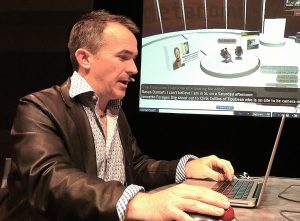 In 2008 Tom Boellstorff published Coming of Age in Second Life: An Anthropologist Explores the Virtually Human. Last month his latest book Ethnography and Virtual Worlds: A Handbook Of Method, cowritten with Bonnie Nardi, Celia Pearce, and T.L. Taylor was published. Recently, Kathleen Cool and I sat down with him (in Second Life, of course) and asked a few questions about how he did it all, his views on the current state of virtual world research, methods and ethics, and the directions he thinks we should be taking. This week we will publish the interview as a four-part series.
In 2008 Tom Boellstorff published Coming of Age in Second Life: An Anthropologist Explores the Virtually Human. Last month his latest book Ethnography and Virtual Worlds: A Handbook Of Method, cowritten with Bonnie Nardi, Celia Pearce, and T.L. Taylor was published. Recently, Kathleen Cool and I sat down with him (in Second Life, of course) and asked a few questions about how he did it all, his views on the current state of virtual world research, methods and ethics, and the directions he thinks we should be taking. This week we will publish the interview as a four-part series.
I was recently at a conference where several graduate students interested in virtual world research asked me how I got started, or how I found communities. When I get these kinds of questions, they are often followed by comments to the effect that they tried Second Life out but never learned how to move around. Or, if they did manage to teleport, they wandered around without ever seeing anyone. They conclude that Second Life is “dead” and move on. They can’t believe that I actually ever found a community, let alone one active enough to become involved with or stay in touch with. With this in mind, I asked Boellstorff to tell us a little about what sparked his interest in virtual world research, how he went about finding people and communities and any advice that he has for young researchers that want to study virtual worlds but don’t know how to start or are afraid of the technical challenges.

Getting Started: The Value of Studying Small
Boellstorff started his research in Second Life two years after beginning his tenure-track position, but by the time it was published he had already received tenure. One of the great benefits of tenure is that it gives you some freedom to try new ideas and branch out to something new (and in any case, his department had no problem with his pursuing his interests wherever they lead). So, he says, “I jumped into the deep end of the pool and joined Second Life while it was still in its infancy. Back then, there were only about 5,000 residents and its maximum concurrency was only about 200”. He told me, “Whenever I hear anyone say that Second Life is not growing, it makes me laugh a little, because that’s missing the point in some respects”.
Anthropologists and other social researchers don’t just study India and China, important as they are. Some of the most significant social research has been based on smaller communities, in some cases of only a few hundred members. Small communities can be incredibly helpful in understanding culture.
Learn How to Live There
We just don’t buy it. You can’t do research in Second Life. You can’t interview them.
Boellstorff gets this a lot. Students at one university challenged him with this question and he asked them why they thought this. They said, “Well, we went into shopping malls and tried to ask questions and no one would answer.” So they hadn’t taken the time to get to know the community: they just appeared out of nowhere and expected people to consent to interviews, even though if in the physical world you just walked up to people in a shopping mall and asked to interview them, they might refuse, or if agreeing just give canned answers since they don’t know who you are. Boellstorff pointed out that this kind of thinking is a common problem with virtual world research. Researchers often think that this kind of work can be done in a weekend. Unfortunately, no research, not even virtual research which you can literally do sometimes in your pajamas, is that easy.
You have to get to know the people you are studying, and they need to get to know you. Why should they want to answer your questions, if you aren’t willing to invest the time to understand anything about their lives?
He feels that a lot of confusion comes from researchers that don’t have a lot of physical world research experience. Some virtual world researchers come from the fields like game studies and expect to be able to enter a virtual world and find a group to study right there waiting for them, a guild or a team of players.  He told me, “Research in a more open-ended virtual world like Second Life is not going to be handed to you on a silver platter: there are no set goals, no leveling up. Second Life and many other online contexts operate much like physical world social contexts in this regard: you have to learn how to live there”. He compared looking for community in Second Life to his experiences in Indonesia.
He told me, “Research in a more open-ended virtual world like Second Life is not going to be handed to you on a silver platter: there are no set goals, no leveling up. Second Life and many other online contexts operate much like physical world social contexts in this regard: you have to learn how to live there”. He compared looking for community in Second Life to his experiences in Indonesia.
When you go to Indonesia there is no set structure, no “levelling”: there are just people living. Most people’s lives are not lived in a public, instantly accessible way. You begin by looking for where people go.
In Indonesia he found people in shopping malls and cafes. In Second Life, you might look for and join groups, clubs, meeting spaces, activities, etc.”
Tom Boellstorff: Be Fearless
Sorry, no shortcuts here!
In terms of learning the technology Boellstorff goes back to Indonesia. To conduct research there he had to learn about Islam, the culture, the language. He says, “Anyone interested in this kind of work has to be willing to sit down and devote some time to figuring out the technology, the rules and conventions. For some disciplines that don’t give students a lot of time for the research stage of their dissertation work, this can be a challenge. This is problematic. You really have to have time to become known to the people that you study.” So, he says, don’t be afraid to invest that time!
If you really take the time to get to know as much detail as possible about the culture or cultures you are studying, it will be much easier to get to know people. And when you do, you find that for the most part, people want to talk about their lives. They find their own lives interesting—because they are!
Tomorrow:
In Part 2, Kathleen Cool will cover her questions with Boellstorff concerning myths and misconceptions about ethnographic research in virtual worlds.

Related Materials
• Tom Boellstorff / UCI
• Tom Boellstorff / Wikipedia
• Coming of Age in Second Life / Princeton University Press
• Ethnography and Virtual Worlds: a handbook of method / Princeton University Press
I M A G E . C R E D I T S
• UCI
• Katie Vizenor
• Rik Panganiban
Congratulations Katie, Kathleen, and of course Tom! You all had such a great conversation. This was a nice post and I’m eagerly awaiting part 2… and 3… and 4… and who knows, maybe there’ll even be a “Part V – Putting it all Together”
Too much waiting for new installments! Why Katie Vizenor, I do believe you are the Yordie Sands of Digital Ethnography!! 😉
You stinker! You act as if I invented multi-part stories here. As I recall I got the idea from someone else.
I’m sure I have no idea what you’re talking about.
I’m sure you don’t either, but still and jus sayin
Thanks so much for doing this with me! It was so much fun – great questions and discussion.
Hi Tom! Great to see you back in and around SL and I hope your Editorship at AA finished as well as you hoped! I’m very excited about this series and will be watching for the 4 posts as they are published.
I have a question for you (and Katie / Kathleen too if you’d like to chime in): I can’t recall if you mentioned it in “Coming of Age…”, but I’m sure you will have addressed it in your latest book (which I still have to get!), but what are the ethics surrounding being studying subjects without their explicit permission? The reasons I ask is because (I believe) I was one of at least 140 subjects involved in a psychologist’s study of virtual sex workers. I’ll leave it to your imagination as to what boundaries may have been crossed – although that’s really not the point of my question.
While I appreciate the methodological advantages behind undercover participant observation, and can understand that anonymity can be safeguarded to an extent by changing names and locations etc.; I also remember being pounded on by my psychology professors who would insist that no prospective study would ever pass an ethics review without a verifiable means of subject permission in place? Was I just naive? Maybe there is a difference in the disciplines between what’s ok in anthropology and what’s ok in pscyhology – but if I remember correctly, it is definitely not ok.
You’re thoughts?
I love the topic and love the discussion. Inquiring minds await Part 2!